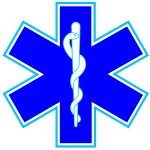Excited Delirium or Drug Induced Agitation
Section 5 -MEDICAL
5.20 EXCITED DELIRIUM SYNDROME / DRUG INDUCED AGITATION
CONSIDER MEDICAL ETIOLOGY OF PSYCHOLOGICAL /BEHAVIORAL DISORDER AND REFER TO APPROPRIATE PRACTICE PARAMETER:
- Hypoxia, INITIAL MEDICAL CARE (2.01).
- Substance Abuse, DRUG OVERDOSE / POISONING (5.05).
- Neurologic Disease, STROKE (5.04).
- Metabolic Derangements, HYPO / HYPERGLYCEMIA (5.10).
- Psychiatric Conditions, PSYCHOLOGICAL BEHAVIORAL EMERGENCIES (5.11).
DEFINITION:
Excited Delirium is defined as an acute state of behavioral disinhibition where an individual displays agitation, aggressiveness or aberrant behavior requiring the use of force to restrain the patient. This behavioral state is likely associated or precipitated with the use of recreational drugs primarily cocaine, methamphetamines or other hallucinogenic drugs. Following a struggle to restrain the patient, his/her demeanor calms down and the condition may deteriorate quickly into respiratory arrest and death.
SIGNS AND SYMPTOMS:
- Physical Signs:
- Dilated pupils
- Profuse sweating
- High core body temperature
- Foaming at the mouth
- Shaking and shivering
- Behavioral:
- Agitation
- Aberrant, aggressive behavior
- Superhuman strength
- Diminished pain sensation
- Delusional / Delirious
- Incoherent speech
- Following restraining:
- Patients may calm down or become unresponsive
- This is an ominous sign! It may progress into respiratory depression and arrest.
- This change in behavior has been equated to “turning the switch off” on the patient.
Establish SCENE AND PERSONAL SAFETY - Call law enforcement personnel to scene if needed. Above all, DO NOTHING TO JEOPARDIZE YOUR OWN SAFETY.
- Determine and document if patient is a threat to self or others or if patient is unable to care or provide for self. Protect patient from harm to self or others.
RESTRAINT:
The patient exhibiting these signs and symptoms will most likely have to be restrained by law enforcement. It may require both physical as well as electrical force. The patient may be subdued using an electrical control device (ECD) or Taser®. Once the patient is restrained and secured by LEO and EMS initiate immediate medical assessment.
INITIAL MEDICAL CARE (2.01):
- Check ABC’s – secure cervical spine if suspicion of trauma
- Support airway and ventilations as needed
- Assess vital signs including
- Oxygen saturation
- Capnography
- Accurate body temperature (oral or temporal or rectal if available)
- Blood glucose level – correct as per Hypoglycemia parameter (5.10)
- Provide high flow oxygen
- All suspected excited delirium syndrome (EDS) patients MUST BE given high flow OXYGEN via NRBM at 10-15 lpm
- Cardiac monitoring
- 3-Lead and 12-Lead ECG – monitor for dysrhythmias
- If the patient goes into arrest the most likely presenting rhythm is asystole
- Treat dysrhythmias as per appropriate parameter
AGITATION:
If patient remains severely agitated, to the point of interfering with patient care and / or becomes a physical danger to the crew’s well being, administer:
- KETAMINE (KETALAR) 2 mg/kg IVP or IN OR 4 mg/kg IM x 1 dose
- If IV is already in place, may give 2mg/kg IV push x 1 dose in lieu of 4mg/kg IM dose, however 'do not place an IV for the purpose of administering ketamine.' Ideal IM administration location is midline lateral thigh, however, deltoid or gluteal administration is permissible if that is the most safely accessed site.
SUSPECTED HYPERTHERMIA:
If the patient is hot to the touch, with severe perspiration, attempt to obtain and document accurate body temperature;
- If the body temperature is greater than 102o F.
- Remove all excessive clothing, cool body with room temperature water.
- May apply ice packs to groin, axillae and neck.
- Move patient to the back of the rescue – turn patient area AC to cool.
- Mix one Sodium Bicarbonate syringe (50 mEq) in one liter of COOLED NORMAL SALINE and infuse at a “wide open” rate. Reassess for hyperthermia and continue COOLED NORMAL SALINE as needed.
REASSESSMENT:
- EDS patients have the potential to deteriorate very quickly. The patient must be reassessed every 3-5 minutes or more frequently if they calm or become unresponsive without being sedated.
POSITIONING FOR TRANSPORT:
- Patient must be transported in a semi-sitting position with hands cuffed or restrained in front of the patient in a way the he/she cannot lift them to reach or hit a crew member
- If legs are restrained they must be straight or with a slight flex on the knees
- If the transport stretcher is capable of elevating the knee portion of the cot use it to help confine the leg motion.
- Straps SHOULD NOT be placed in a way that would restrict the patient’s respiratory effort or chest excursion.
- If legs are restrained they must be straight or with a slight flex on the knees
- Patients MUST NEVER be transported face down or prone on the stretcher.
- Never “sandwich” a patient on the stretcher (placing the patient prone and using a backboard to secure the patient to it).
- Patients MUST NOT be transported with hands cuffed behind the patient or in a position that is likely to restrict or limit the patient’s ability to breathe.
- Excessive clothing must be removed as much as possible while protecting the patient’s modesty to help cooling down the possible hyperthermia.
TASER® PROBES:
- Taser® Probes may be removed as per procedure parameter 9.27
- Enlist the assistance from LEO to remove Taser® probes from the patient according to their policies if needed as part of their investigation
TRANSPORT:
- If applicable, consult law enforcement for assistance with transport of the unwilling / combative patient to the hospital
- ALL SUSPECTED EXCITED DELIRIUM patients MUST BE TRANSPORTED TO AN INITIAL RECEIVING FACILITY for further evaluation
